91--商务英语翻译期chapter_18_汉英翻译中的中式英语
- 格式:ppt
- 大小:525.50 KB
- 文档页数:25
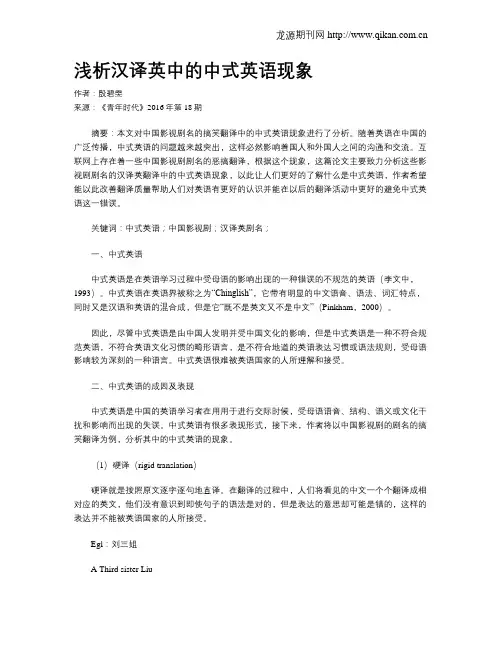
浅析汉译英中的中式英语现象作者:殷碧雯来源:《青年时代》2016年第18期摘要:本文对中国影视剧名的搞笑翻译中的中式英语现象进行了分析。
随着英语在中国的广泛传播,中式英语的问题越来越突出,这样必然影响着国人和外国人之间的沟通和交流。
互联网上存在着一些中国影视剧剧名的恶搞翻译,根据这个现象,这篇论文主要致力分析这些影视剧剧名的汉译英翻译中的中式英语现象,以此让人们更好的了解什么是中式英语,作者希望能以此改善翻译质量帮助人们对英语有更好的认识并能在以后的翻译活动中更好的避免中式英语这一错误。
关键词:中式英语;中国影视剧;汉译英剧名;一、中式英语中式英语是在英语学习过程中受母语的影响出现的一种错误的不规范的英语(李文中,1993)。
中式英语在英语界被称之为“Chinglish”,它带有明显的中文语音、语法、词汇特点,同时又是汉语和英语的混合成,但是它“既不是英文又不是中文”(Pinkham,2000)。
因此,尽管中式英语是由中国人发明并受中国文化的影响,但是中式英语是一种不符合规范英语,不符合英语文化习惯的畸形语言,是不符合地道的英语表达习惯或语法规则,受母语影响较为深刻的一种语言。
中式英语很难被英语国家的人所理解和接受。
二、中式英语的成因及表现中式英语是中国的英语学习者在用用于进行交际时候,受母语语音、结构、语义或文化干扰和影响而出现的失误。
中式英语有很多表现形式,接下来,作者将以中国影视剧的剧名的搞笑翻译为例,分析其中的中式英语的现象。
(1)硬译(rigid translation)硬译就是按照原文逐字逐句地直译。
在翻译的过程中,人们将看见的中文一个个翻译成相对应的英文,他们没有意识到即使句子的语法是对的,但是表达的意思却可能是错的,这样的表达并不能被英语国家的人所接受。
Egl:刘三姐A Third sister LiuB Liu sanjie(The Third Sister of the Liu Family)刘三姐,是民间传说的壮族人物,古代民间的传说歌手。
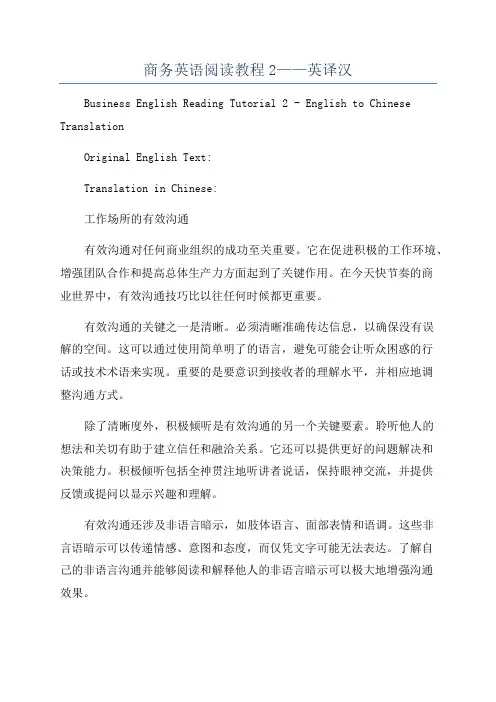
商务英语阅读教程2——英译汉Business English Reading Tutorial 2 - English to Chinese TranslationOriginal English Text:Translation in Chinese:工作场所的有效沟通有效沟通对任何商业组织的成功至关重要。
它在促进积极的工作环境、增强团队合作和提高总体生产力方面起到了关键作用。
在今天快节奏的商业世界中,有效沟通技巧比以往任何时候都更重要。
有效沟通的关键之一是清晰。
必须清晰准确传达信息,以确保没有误解的空间。
这可以通过使用简单明了的语言,避免可能会让听众困惑的行话或技术术语来实现。
重要的是要意识到接收者的理解水平,并相应地调整沟通方式。
除了清晰度外,积极倾听是有效沟通的另一个关键要素。
聆听他人的想法和关切有助于建立信任和融洽关系。
它还可以提供更好的问题解决和决策能力。
积极倾听包括全神贯注地听讲者说话,保持眼神交流,并提供反馈或提问以显示兴趣和理解。
有效沟通还涉及非语言暗示,如肢体语言、面部表情和语调。
这些非言语暗示可以传递情感、意图和态度,而仅凭文字可能无法表达。
了解自己的非语言沟通并能够阅读和解释他人的非语言暗示可以极大地增强沟通效果。
在技术时代,电子沟通已成为工作场所沟通的重要组成部分。
虽然电子邮件、即时消息和视频会议提供了便利和效率,但它们不能取代面对面的互动。
在虚拟和面对面沟通之间保持平衡是确保信息有效和有意义交流的关键。
最后,反馈对于有效沟通至关重要。
建设性的反馈帮助个人了解自己的长处和弱点,使其能够提高自己的沟通技巧。
反馈应具体、及时和可操作,才能发挥作用。
它应该关注行为或行动,并避免个人批评。
总之,有效沟通对任何商业组织的成功至关重要。
它涉及到清晰度、积极倾听、非语言暗示、电子和面对面沟通的平衡以及建设性反馈。
通过发展和实践这些技能,个人可以成为更有效的沟通者,并为积极和富有成效的工作环境做出贡献。
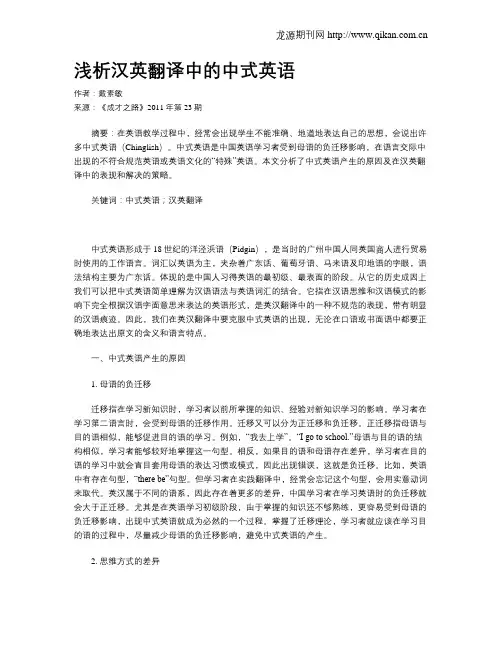
浅析汉英翻译中的中式英语作者:戴素敏来源:《成才之路》2011年第23期摘要:在英语教学过程中,经常会出现学生不能准确、地道地表达自己的思想,会说出许多中式英语(Chinglish)。
中式英语是中国英语学习者受到母语的负迁移影响,在语言交际中出现的不符合规范英语或英语文化的“特殊”英语。
本文分析了中式英语产生的原因及在汉英翻译中的表现和解决的策略。
关键词:中式英语;汉英翻译中式英语形成于18世纪的洋泾浜语(Pidgin),是当时的广州中国人同英国商人进行贸易时使用的工作语言。
词汇以英语为主,夹杂着广东话、葡萄牙语、马来语及印地语的字眼,语法结构主要为广东话。
体现的是中国人习得英语的最初级、最表面的阶段。
从它的历史成因上我们可以把中式英语简单理解为汉语语法与英语词汇的结合。
它指在汉语思维和汉语模式的影响下完全根据汉语字面意思来表达的英语形式,是英汉翻译中的一种不规范的表现,带有明显的汉语痕迹。
因此,我们在英汉翻译中要克服中式英语的出现,无论在口语或书面语中都要正确地表达出原文的含义和语言特点。
一、中式英语产生的原因1. 母语的负迁移迁移指在学习新知识时,学习者以前所掌握的知识、经验对新知识学习的影响。
学习者在学习第二语言时,会受到母语的迁移作用。
迁移又可以分为正迁移和负迁移。
正迁移指母语与目的语相似,能够促进目的语的学习。
例如,“我去上学”。
“I go to school.”母语与目的语的结构相似,学习者能够较好地掌握这一句型。
相反,如果目的语和母语存在差异,学习者在目的语的学习中就会盲目套用母语的表达习惯或模式,因此出现错误,这就是负迁移。
比如,英语中有存在句型,“there be”句型。
但学习者在实践翻译中,经常会忘记这个句型,会用实意动词来取代。
英汉属于不同的语系,因此存在着更多的差异,中国学习者在学习英语时的负迁移就会大于正迁移。
尤其是在英语学习初级阶段,由于掌握的知识还不够熟练,更容易受到母语的负迁移影响,出现中式英语就成为必然的一个过程。
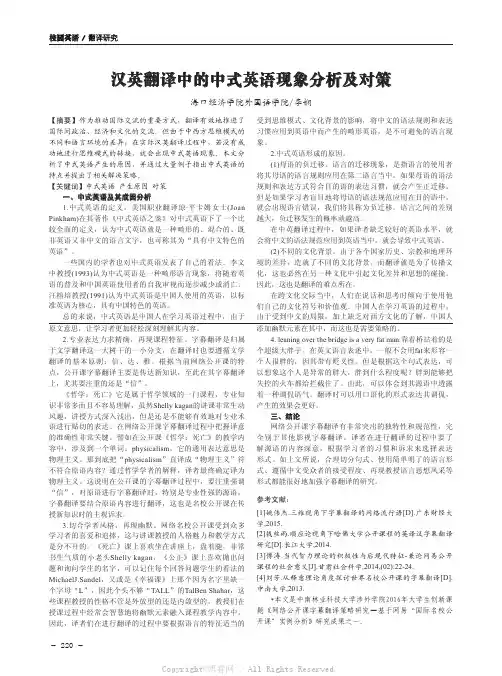
- 220-校园英语 / 翻译研究原文意思,让学习者更加轻松深刻理解其内容。
2.专业表达力求精确,再现课程特征。
字幕翻译是归属于文学翻译这一大树干的一小分支,在翻译时也要遵循文学翻译的基本原则:信、达、雅。
根据当前网络公开课的特点,公开课字幕翻译主要是传达新知识,至此在其字幕翻译上,尤其要注重的还是“信”。
《哲学:死亡》它是属于哲学领域的一门课程,专业知识非常多而且不容易理解,虽然Shelly kagan 的讲课非常生动风趣,讲授方式深入浅出,但是还是不能够有效地对专业术语进行贴切的表达。
在网络公开课字幕翻译过程中把握译意的准确性非常关键。
譬如在公开课《哲学:死亡》的教学内容中,涉及到一个单词:physicalism ,它的通用表达意思是物理主义。
那到底把“physicalism ”直译成“物理主义”符不符合原语内容?通过哲学学者的解释,译者最终确定译为物理主义。
这说明在公开课的字幕翻译过程中,要注重强调“信”,对原语进行字幕翻译时,特别是专业性强的源语,字幕翻译要结合原语内容进行翻译,这也是名校公开课在传授新知识时的主观诉求。
3.切合学者风格,再现幽默。
网络名校公开课受到众多学习者的喜爱和追捧,这与讲课教授的人格魅力和教学方式是分不开的。
《死亡》课上喜欢坐在讲座上,盘着腿,非常书生气质的小老头Shelly kagan ,《公正》课上喜欢抛出问题和询问学生的名字,可以记住每个回答问题学生的看法的 MichaelJ.Sandel ,又或是《幸福课》上那个因为名字里缺一个字母“L ”,因此个头不够“TALL ”的TalBen Shahar ,这些课程教授的性格不管是外放型的还是内敛型的,教授们在授课过程中经常会智慧地将幽默元素融入课程教学内容中。
因此,译者们在进行翻译的过程中要根据语言的特征适当的添加幽默元素在其中,而这也是需要策略的。
4. leaning over the bridge is a very fat man.靠着桥站着的是个超级大胖子。

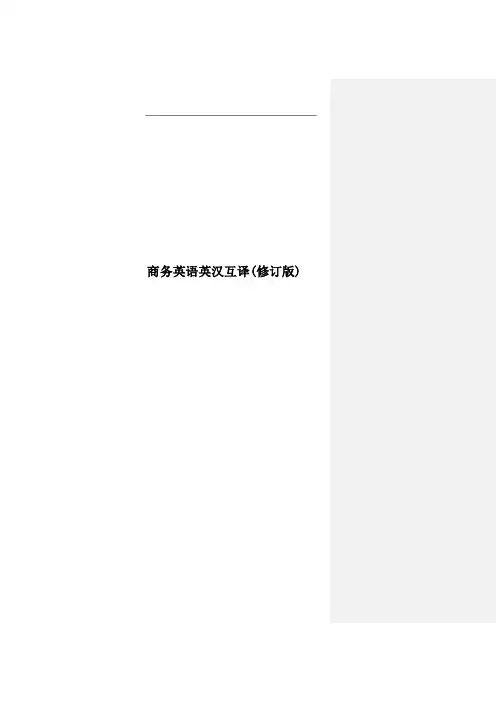

汉英翻译中的中式英语及其改善措施摘要:随着我国改革开放和全球经济一体化,我国与其他国家之间的交流与沟通越来越频繁。
英语已经发展为一门世界性语言,并且成为我国对外交流的主要工具;而翻译便成为必要的交流形式。
然而,在翻译过程中普遍存在“中式英语”的现象。
译者拘泥于原文字面,“对号入座”,使得译文生硬晦涩,不符合英语的习惯表达,并带有明显的汉语特征,因而不能被以英语为母语者所接受。
它的存在严重影响了翻译的质量以及我国的对外交流。
针对这一问题,本文对中式英语进行了较系统的研究,旨在给中国英语学习者一个借鉴,在翻译过程中尽量减少使用中式英语,提高汉英翻译的质量。
本文共分为五大部分,从三个方面对中式英语进行论述。
第一个方面从中式英语的定义入手,对中式英语进行了一个简单介绍,并分析了它的六种错误类型,通过大量例子,较详细的描述了汉英翻译中的中式英语的表现形式;第二个方面则利用对比分析指出其产生的根本原因,即中西思维模式的差异以及母语的干扰;第三个方面针对中式英语的产生原因及表现形式,提出了五大改善措施,以减少和避免汉英翻译中中式英语的现象。
关键词:中式英语;思维模式差异;母语的干扰Chinglish in Chinese-English Translation and Possible SolutionsAbstract: With China‟s reform and opening-up policy and economic globalization, Chinese people are communicating with foreign countries in every aspect. English has developed as a widely used language to fulfill international communication, and translation has become a necessary method. However, a phenomenon exists commonly in Chinese- English translation, that is, Chinglish. The translators just rigidly stick to original words, and their translations turn out to be obscure and not consistent with English habits or rules but with Chinese characteristics, which cannot be accepted by English native speakers. Consequently, Chinglish seriously affects the translation quality and our communication with the world, and the international status of our country.This paper is an attempt to study Chinglish in Chinese-English translation. It consists of three parts. Part one describes Chinglish with interlanguage and analyzes the basic causes of Chinglish that are thought pattern difference between Chinese and English and interference of mother tongue. From the aspects of six sorts of errors, part two demonstrates main manifestations of Chinglish in C-E translation with a large number of examples. Part three offers some possible solutions with an aim to reduce or evade Chinglish in Chinese-English translation to the largest extent.Key words: Chinglish; thought pattern difference; mother tongue interferenceTable of ContentsI. Introduction (1)II. Chinglish (1)A. Definition of Chinglish (1)B. Manifestations of Chinglish in Chinese-English Translation (2)1. Unnecessary Words (2)2. Rigid Translation (4)3. Misuse of Words (4)4. Incorrect Word Order (6)5. Incorrect Subject (7)6. Incorrect Negation (8)III. Basic Causes of Chinglish (9)A. Thought Patterns Differences (9)B. Mother Tongue Interference (11)IV. Possible Solutions to Chinglish in Chinese-English Translation (12)A. Knowing More about English Thought Patterns (12)B. Accumulating Chinglish Examples (13)C. Doing More Translation Practice (14)D. Adapting good ways in using dictionaries (14)E. Watching more English movies and TV drama programs (15)V. Conclusion (15)I. IntroductionSince English has developed as an international language, study on various English versions on the linguistics, culture and cognition has become an important subject in the international language study field.Scholars home and abroad have been devoting themselves to studying Chinglish for years. Li Wenzhong distinguished Chinglish from Chinese English. He thought that Chinese English was not a hypothesis but an objective phenomenon with expansive prospect and study value, while Chinese English was distorted English and would be gradually reduced or eliminated along with the wide use of English and Chinese English learners‟. On the basis of interlanguage, both Chinese English and Chinglish were interlanguage variations produced by Chinese and affected by Chinese culture, and they were inevitable. There are two causes of Chinglish. First, the misunderstanding of the original and for the second was being not familiar with English characteristics and adopting Chinese collocations and structures. Joan Pinkham, an American professional translator, systematically classified Chinglish manifestations and corrected them with specific analysis.The author of this paper agrees that Chinglish is objective and unavoidable for Chinese English learners but needs improvement. This paper studies Chinglish in Chinese-English translation, discussing its definition, causes and solutions with a large number of examples.II. ChinglishChinglish has existed for a long history, even since Chinese began to study and use English. In the early 1980s, some foreign experts pointed out that some phrases or structures in some published Chinese magazines and newspapers did not conform to Standard English actually. Because it manifests Chinese feature, they called this kind of English “Chinglish” (Ma Xuehong 79).A. Definition of ChinglishChinglish is defined by Joan Pinkham who is an American language expert in her book The Translator’s Guide to Chinglish: “Chinglish, of course, is that misshapen, neither English nor Chinese but that might be described as …English with Chinese characteristics”. It does not conform to Standard English and cannot be understood or accepted by English native speakers, so it is playing a negative role in communicating with English people.In the strict sense, Chinglish is the interlanguage of Chinese learners between Chinese and English. Two of the characteristics of interlanguage are cited: (Pinkham 32) (1)It is dynamic, and full of errors, and is in the process of constant change towards astandard target language system.(2)The learner‟s competence is transitional. It is subject to constant revision, passes through a number of stages, and forms the “interlanguage continuum”.Another feature is fossilization which is defined as a process occurring from time to time in which incorrect linguistic features become a permanent part of the way a person speaks or writes a language.Being Chinese, we generally cannot reach the same level of competence as English natives. Our “final state”grammar is not standard English grammar. Thus, certain rules and items “fossilize”. Typical errors are “he have…”and “she go to school yesterday”, etc.According to the definitions of Chinglish and interlanguage and the characteristics of interlanguage,a conclusion can be drawn that Chinglish is an interlanguage of Chinese learners of English, and is neither Chinese nor English but stands between them.B. Manifestations of Chinglish in Chinese-English TranslationIt has been discussed in chapter one that thought is the basis of language, so the thought pattern difference will affect the transformation of the languages. Translation is a language activity that reexpresses the thought of language by another language accurately and entirely. In this sense, translation should not be merely viewed as the transformation of languages, but also the transformation of thought patterns. Besides, the structure difference between the two languages will also affect the translation. When translating, many Chinese English learners only pay attention to the language replacement, neglecting the differences of thought patterns and structures. Consequently, Chinglish appears. For a clearer cognition of this phenomenon, this chapter classifies it to six sorts of errors that are rigid translation, unnecessary words, and misuse of words, incorrect word order, incorrect subject and incorrect negation.1. Unnecessary WordsA sentence should contain no unnecessary words, a paragraph no unnecessary sentence. It is said that any words which perform no function in the sentence—that is, which add nothing to the meaning—should be edited out.However, almost every text translated from Chinese into English contains unnecessary words. Namely, unnecessary words appear in a large number of phrases and sentences. Unnecessary words are thehallmark of Chinglish. Let‟s see the following examples.(1) 确保中美两国之间紧密的合作关系。
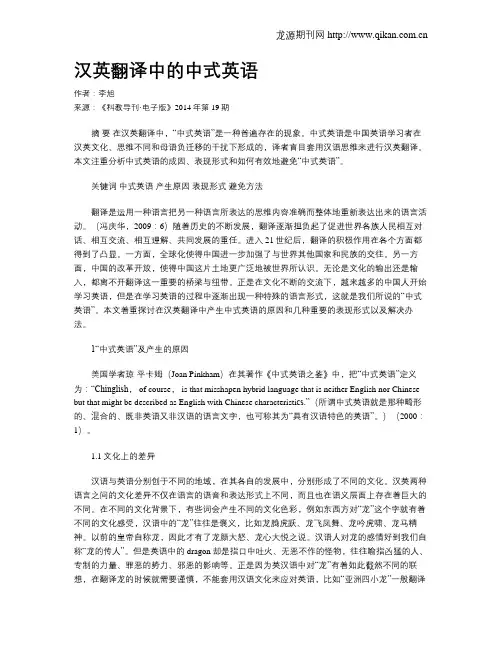
汉英翻译中的中式英语作者:李旭来源:《科教导刊·电子版》2014年第19期摘要在汉英翻译中,“中式英语”是一种普遍存在的现象。
中式英语是中国英语学习者在汉英文化、思维不同和母语负迁移的干扰下形成的,译者盲目套用汉语思维来进行汉英翻译。
本文注重分析中式英语的成因、表现形式和如何有效地避免“中式英语”。
关键词中式英语产生原因表现形式避免方法翻译是运用一种语言把另一种语言所表达的思维内容准确而整体地重新表达出来的语言活动。
(冯庆华,2009:6)随着历史的不断发展,翻译逐渐担负起了促进世界各族人民相互对话、相互交流、相互理解、共同发展的重任。
进入21世纪后,翻译的积极作用在各个方面都得到了凸显。
一方面,全球化使得中国进一步加强了与世界其他国家和民族的交往。
另一方面,中国的改革开放,使得中国这片土地更广泛地被世界所认识。
无论是文化的输出还是输入,都离不开翻译这一重要的桥梁与纽带。
正是在文化不断的交流下,越来越多的中国人开始学习英语,但是在学习英语的过程中逐渐出现一种特殊的语言形式,这就是我们所说的“中式英语”。
本文着重探讨在汉英翻译中产生中式英语的原因和几种重要的表现形式以及解决办法。
1“中式英语”及产生的原因美国学者琼·平卡姆(Joan Pinkham)在其著作《中式英语之鉴》中,把“中式英语”定义为:“Chinglish, of course, is that misshapen hybrid language that is neither English nor Chinese but that might be described as English with Chinese characteristi cs.”(所谓中式英语就是那种畸形的、混合的、既非英语又非汉语的语言文字,也可称其为“具有汉语特色的英语”。
)(2000:1)。
1.1文化上的差异汉语与英语分别创于不同的地域,在其各自的发展中,分别形成了不同的文化。
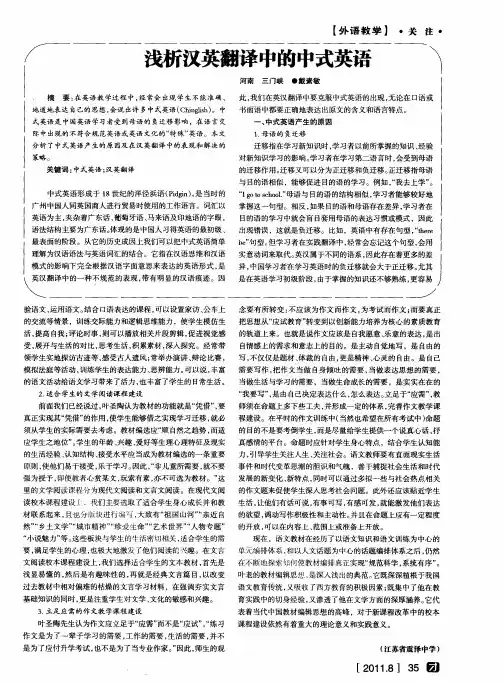
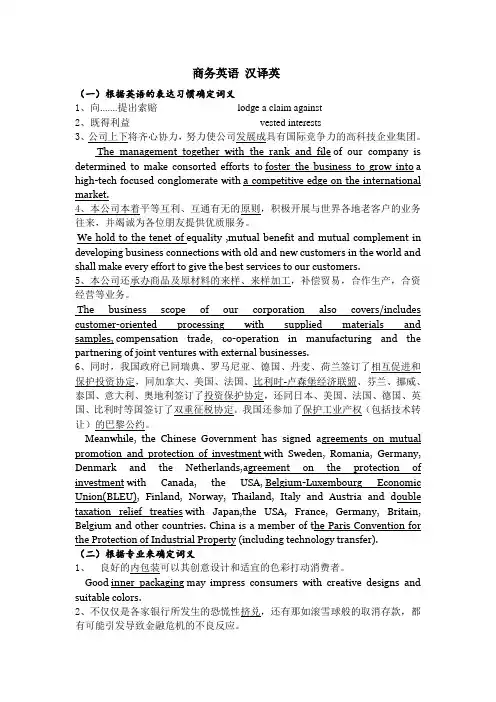
商务英语汉译英(一)根据英语的表达习惯确定词义1、向.......提出索赔lodge a claim against2、既得利益vested interests3、公司上下将齐心协力,努力使公司发展成具有国际竞争力的高科技企业集团。
The management together with the rank and file of our company is determined to make consorted efforts to foster the business to grow into a high-tech focused conglomerate with a competitive edge on the international market.4、本公司本着平等互利、互通有无的原则,积极开展与世界各地老客户的业务往来,并竭诚为各位朋友提供优质服务。
We hold to the tenet of equality ,mutual benefit and mutual complement in developing business connections with old and new customers in the world and shall make every effort to give the best services to our customers.5、本公司还承办商品及原材料的来样、来样加工,补偿贸易,合作生产,合资经营等业务。
The business scope of our corporation also covers/includes customer-oriented processing with supplied materials and samples, compensation trade, co-operation in manufacturing and the partnering of joint ventures with external businesses.6、同时,我国政府已同瑞典、罗马尼亚、德国、丹麦、荷兰签订了相互促进和保护投资协定,同加拿大、美国、法国、比利时-卢森堡经济联盟、芬兰、挪威、泰国、意大利、奥地利签订了投资保护协定,还同日本、美国、法国、德国、英国、比利时等国签订了双重征税协定。
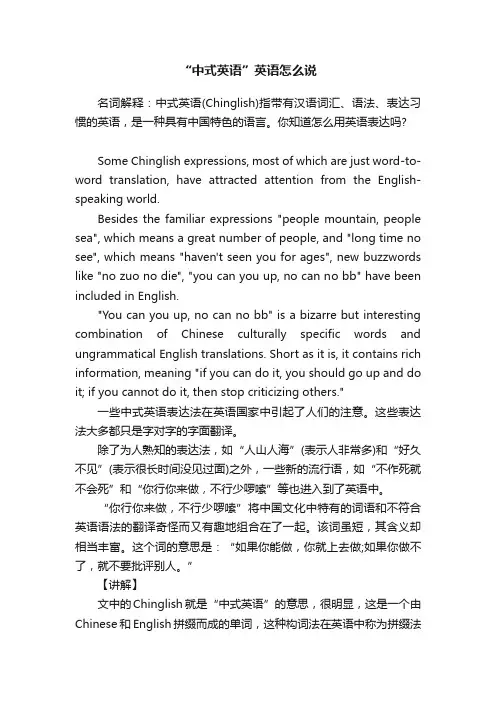
“中式英语”英语怎么说名词解释:中式英语(Chinglish)指带有汉语词汇、语法、表达习惯的英语,是一种具有中国特色的语言。
你知道怎么用英语表达吗?Some Chinglish expressions, most of which are just word-to-word translation, have attracted attention from the English-speaking world.Besides the familiar expressions "people mountain, people sea", which means a great number of people, and "long time no see", which means "haven't seen you for ages", new buzzwords like "no zuo no die", "you can you up, no can no bb" have been included in English."You can you up, no can no bb" is a bizarre but interesting combination of Chinese culturally specific words and ungrammatical English translations. Short as it is, it contains rich information, meaning "if you can do it, you should go up and do it; if you cannot do it, then stop criticizing others."一些中式英语表达法在英语国家中引起了人们的注意。
Eg.1.你的身材很美:Y our figure is beautiful.Y ou have a fair figure. 2. 我工作很忙My work is busy.I am very busy.3. 学习知识To learn knowledgeTo acquire knowledge4. 达到自给自足To achieve self-sufficiency To reach self-sufficiency 5.生活水平Standard of lifeQuality of life6.严密控制Close controlStrict/rigid control7.好票Good ticketsGood seats8.强硬政策Strong policyTough policy9.取得成就Make achievementsAttain achievements10.价钱太贵The price is too expensiveThe price is too high11.恢复经济Recover the economyReconstruct the economy12.打扫房子Sweep the houseClean the house13.我们赢了你们队We have won your teamWe have beaten your team14.维护世界和平是大有希望的To maintain world peace is very hopeful The prospect for world peace is very bright.新世纪即将到来之际,。
译文1 as the new century approaches,..译文2 on the verge of the new century…译文3 at the dawn of the new century.译文4 at the threshold of the new century.译文5as the new century is just round the corner,…练习:1.最近20多年来,中国实行改革开放,综合国力大大提升,与中国打交道,对中华文化感兴趣的国家、国际组织和人员日益增多。
高级商务英语阅读课文译文第1 课主课文译文新长征“中国制造”这个标记很久以前就不新鲜了,它贴在鞋子上、玩具上、服装上,以及为跨国公司制造的其他商品上,世界各地到处可见。
现在真正新鲜的是以中国品牌出售的中国制造的商品。
目前中国只有为数不多的几家公司拥有足够的财力和管理知识来打造国际名牌;其余的绝大多数公司还在为在国内获得知名度而努力奋斗着。
但是正在海外市场上试水的各大先锋公司,很有可能把事情做大。
一些人认为,在创业精神饱满的本地管理层的协助下,或者在一些想在其产品系列里添加新产品的外国公司的协助下,中国商品在极具竞争力的价格的基础上,若把卖点放在产品质量和异国情调上,那末10 年之内,中国品牌将一个一个地走向全球。
总部在香港的广告公司中国精信(Grey China)的执行董事陈一木丹(Viveca Chan)说:“如果世界上只有一个国家具备创立全球品牌的潜力,那么这个国家就是中国。
”短期之内,中国商品最有希望打入国际市场的当属中草药和特色食品,当然也包括那些体现中国浪漫并具有异国情调的产品,例如化妆品、时装和音乐作品。
中国总部设在上海的泰勒·娜尔森·索福瑞(Taylor Nelson Sofres)市场调研公司的中国区总经理Kevin Tan 说:“与中国相联系的神秘色彩还有许多。
化妆品是种靠形象推销的产品,假如你要做化妆品,你会一下子就发现,中国化妆品来头不小。
”努力走向世界的中国品牌还有一些领导时尚潮头的饮料和啤酒品牌,也包括家用电器等具有品牌潜力的产品,它们都能以竞争性的价格提供高品质的产品。
这些中国品牌中的一部分,最终将会通过合资、兼并和收购的途径走向国际市场。
而对于合资双方中的外国投资者来说,这些品牌则将成为他们更快地进入中国消费市场和销售渠道的载体,同时这些中国品牌也能进一步充实国外投资者在国际市场上已经确立的优质品牌的阵营。
整个20 世纪90 年代,“中国品牌”这个概念一直在发育着,而目前在国内受到的重视更大了。
汉英翻译中的中式英语现象及原因分析作者:刘晓飞来源:《文学教育》 2014年第8期刘晓飞近年来,随着各类英语考试对书面表达能力的要求不断提高,英语翻译教学越来越受到广大中国教师和学生的重视。
然而,很多学生的译文无法切题,思路混乱,语言支离破碎,根本的原因在于没有走出中式思维模式造成的误区,经常出现类似“Good good study, day day up”这样的中式英语,或者叫Chinglish。
中式英语被称之为“具有汉语特色的英语”,是一种汉语及英语混合而成的合体语言。
国内学者一般认同的定义是指中国的英语学习和使用者由于受母语的干扰和影响,硬套汉语规则和习惯,在英语交际中出现的不合规范英语或不合英语文化习惯的畸形英语。
我国清代翻译家严复提出翻译的标准应做到“信”、“达”、“雅”,即译文要忠实于原文,又要通顺流畅,应符合目标语的语言表达习惯。
但是由于受到汉语文化以及思维方式的影响,在翻译实践中往往出现明显带有汉语痕迹而不符合英语表达习惯的句子,极大地影响了学生对英语的综合运用能力,必须在教学过程中给予足够的重视。
中式英语的产生有以下几个原因:(一)中西方文化的差异语言是社会的产物,是人类历史和文化的结晶。
任何一种语言都与文化密不可分。
文化的共性使翻译成为可能,但其语言文化的个性又为翻译活动设置了障碍。
中国学生由于长期受到汉语言文化的熏陶,对不同语言文化的个性了解不足,导致在跨文化交际中产生信息差,很容易出现“中式英语”。
例如,龙在中国文化中被描述成一种能呼风唤雨的动物,是权力、财富及祥和的象征是权力、财富、繁荣及祥和的象征。
但在西方文化中,龙被认为成是一种类似巨型爬行动物,长着翅膀口中喷火的怪物,是邪恶和暴力的标志。
因此,如果把成语“望子成龙”翻译成:Eager to see one’s son become a dragon,那么将会使西方人产生何种意象?若译为:to expect one’s son to become an outstanding personage将能达到更好的理解效果。
浅析汉英翻译中的中式英语作者:刘彬彬来源:《读写算》2013年第41期摘要:本文主要阐述了汉英翻译中的中式英语一些基本定义和形式。
笔者通过分析原因,提出了解决翻译中的中式英语的一些方法。
关键词:汉英翻译中式英语方法一、中式英语定义中式英语(Chinglish)一词由来已久,中国式英语是指中国的英语学习和使用者由于受母语的干扰和影响,硬套汉语规则和习惯,在英语交际中出现的不合规范英语或不合英语文化习惯的畸形英语。
二、翻译中的中式英语学生学习英语时自然是先接触英汉互译,在母语基础上对英语进行同化处理,所以中英对照翻译学习成了学习者认知英语的手段之一。
学习者通过一对一的记忆来达到对英语的认知。
如英语中 big 就是汉语的"大",所以当要用英语翻译"一大早"时,他们就翻译成 a big morning,而没有顺应英语中很早的含义,从而做出相应的变化译成 early in the morning。
还有诸如马路译成horse road 等典型中式英语现象。
在词汇方面一词多译现象很多,但实际上含义不尽等同,如英语中的 look,see,watch 等都译成汉语的"看",学习者在翻译看书时就成了look a book。
不仅仅词汇翻译过程中容易产生中式英语,在句子互译中中式英语更难纠正。
由于汉语和英语的语法体现和行文习惯差异导致在句子翻译过程中容易出现诸如时态,修辞等方面中式英语。
主语是动作的发出者,宾语是承受者,这是汉语两种语言的共同点。
汉语中没有时态和词的单复数之分,在英语学习过程中学习者会有意识地进行同化认同而忽视英汉语言体系的差异。
英语名词有单复数之分,在名词后有词形的变化,而汉语则没有。
例如,一本书是 a book,而两本书就是 twobooks。
名词作主语,相应的谓语动词须随单复数做相应的改变。
学习者在翻译活动中习惯性地认同了汉语语言习惯而忽视了数的变化。
论汉英翻译中的中式英语摘要:具有汉语的思维方式及汉语的语言结构与特征的英语即通常所谓的Chinglish, 即中式英语。
但是,在目前环境下,汉英翻译绝大多数由具有汉语语言文化背景的中国人来完成,在翻译过程中,译者很容易运用汉语的思维模式以及汉语的语言结构来行文,这样,其最终的的产品—英译文—很容易表现出汉语的思维方式特征以及汉语的语言结构特征。
这篇文章中式围绕“什么是中国英语和中式英语“;“中式英语到底是怎样产生的?”;“它们有哪些表现形式?”等方面展开探讨。
关键词:中国英语;中式英语;产生原因;表现形式;一、理论探讨中国英语(China English)不同于中式英语,中国英语是以规范的英语为核心,用以表达中国特有事物与现象的一种英语变体。
而中式英语则是在汉英翻译过程中,因过分拘泥与原文字句而机械的从字面意义上以“对号入座”的方式来表述,导致一种在字面上看是英语译文但实际上却不符合英文表达习惯的言语形式,它暂不属于任何英语变体。
二、中式英语产生的原因及其表现形式1、用英文表达时以汉语的思维模式来进行这是产生中式英语的最重要、也是最自然的原因。
比如,在用英语表达“你的身材很好”这句话时,说”Your figure is beautiful”就是中式英语,地道的英文表达应该是”You have a fair figure”。
2、对带有中国特色的词汇在英语中无法找到对英语而进行直译随着中国的不断发展,新兴词汇不断涌现,而这些词汇带有中国特色,在英语中一时无法找到对应的表达,这时英译文往往采用解释性或字字对译的方式进行翻译,这时就会出现中式英语。
例如,将“国际关系民主化”翻译成”democratization of international relations”,而正确的译文为”Democracy should be practiced in international relations”。
3、因搭配不当而导致的中式英语由于汉英两种语言的发展历史与民族习惯不同,其各自的词汇搭配存在差别,因此,在汉英翻译中一律使用汉语的搭配方法去套译英语的词汇搭配,也会产生中式英语。